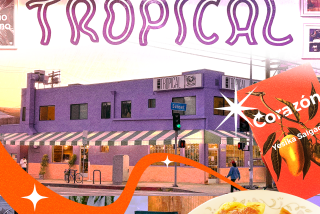Culture : Castro’s Revolutionary Cry: Let Them Eat Ice Cream! : * Cubans flock to a Havana parlor to eat the sweet scoops. It’s a source of pleasure and national pride. And it has even become a dietary staple in days of stringent rationing.
- Share via
HAVANA — A quarter-century ago, Fidel Castro ordered his ambassador to Canada to ship him 28 containers of Howard Johnson’s ice cream, one of each flavor. After tasting them all, Castro declared that his Cuban revolution must produce a quality ice cream of its own.
So the Communist government plunged headlong into the helado business. An ice cream factory sprang up on the highway to Havana’s airport, while an abandoned hospital in the city’s busy Vedado district came down to make way for one of the world’s largest ice cream parlors.
Cecilia Sanchez, Castro’s private secretary and close companion since their guerrilla days, took charge of the enterprise and named it Coppelia, after her favorite ballet. She designed the plaid skirts worn by waitresses at the two-story parlor since its inauguration June 4, 1966.
As the revolution matured, Coppelia sprouted scores of branches in cities and towns across the Caribbean island. By 1980, the year Sanchez died, it was serving more than 50 flavors, from almond to walnut.
Today, as the demise of Cuba’s Communist allies forces tighter and tighter rations of nearly every consumer item here, Coppelia remains an oasis of plenty. The lines are longer and the flavors fewer, but those cold, sweet 50-centavo scoops never run out. Cubans can still buy as much as they can eat.
Indeed, Coppelia is such an icon in Cuba that many believe it must be kept going at any cost.
“If Cuba ran out of ice cream, they’d have to close Coppelia and the people would never stand for that,” declared Oildo Hernandez, 76, seated at the parlor’s open-air cafe with four generations of his family.
The parlor is a sprawling, star-shaped structure that looks as if it came from outer space. By the time it opens at 10:45 each morning, hundreds of people are lined up outside to buy the tickets that are exchanged for ice cream. During the 39-nation Pan American Games in August, with Cuba’s tropical heat at a scorching peak and wilted tourists filling the adjacent Habana Libre Hotel, the wait for a scoop often exceeded two hours.
“As you can see, practically the whole city of Havana comes here for refreshment,” said Pedro Delgado, who manages the parlor from a small office overlooking its two-square-block gardens. “Coppelia is the heart of the city.”
By the time the parlor closes each night at 1:45 a.m., its 414 employees have served 4,250 gallons of ice cream to 35,000 customers in four outdoor cafes, a covered bar and four indoor salons with piped-in rock music.
If the weather is especially hot and stocks run low, Delgado picks up the phone and the factory makes an emergency delivery.
“Never, never, never since the triumph of the revolution have we run out of ice cream,” he said. “Never!”
But it almost happened.
The crisis came last year when Communist East Germany, then Cuba’s second-largest trading partner, merged with the West and halted millions of dollars in food shipments to the island, including tons of powdered milk. The Soviet Union, its economy in trouble, cut back exports of butter. Cuba had no hard currency to buy these previously bartered products elsewhere, and its cows could not supply enough milk to meet the demands of its 10.7 million people for butter and cream.
Cuba had to choose between butter and ice cream.
It chose ice cream.
“In a hot climate like ours, a cold, appetizing treat like ice cream is really important,” explained Eugenio R. Balari, head of the government’s Institute for Research and Orientation of Internal Demand. “Ice cream is a good source of nutrition. It has calories, fat, protein. That is perhaps why we defend it.”
Besides, Coppelia has grown into such an industry that “defending” ice cream means saving the livelihoods of several thousand employees. And along with ice cream and jobs is Coppelia’s social significance as the “people’s park” of Havana.
“It’s a pickup place for the under-25 crowd,” said Gillian Gunn, a Cuba specialist at the Carnegie Endowment for International Peace, who visits the parlor when he is in Havana. “Take away Coppelia and Castro will have big problems with that generation.”
So while Cubans must survive on rations that include two cans of condensed milk per month, a pound of chicken every fortnight, four eggs a week, two rolls a day and butter on rare occasions, they can still pig out on ice cream at Coppelia.
And as they do, ice cream is becoming less a dessert and more a staple of Cuba’s diminishing diet.
The average purchase of a Coppelia customer, according to the manager’s statistics, is about one pint, or four large scoops. While one large scoop goes for half a peso, the best seller at Coppelia these days is a “salad” of five slightly smaller scoops costing 1 1/2 pesos. For the average Cuban worker, that’s an hour and a half’s wages; for foreigners changing money on the black market, it’s a dime.
One recent afternoon, between the lunch and dinner hours, three Cuban university students with big appetites sat at an outdoor table with 12 ice cream salads. In the middle of the table was a thermos bucket, on top of which one of the women had stuck a wad of chewing gum. What they couldn’t finish in one sitting, they said, would go home in the bucket.
“If I eat lunch, I come here later for two salads,” a student named Iracema said. “If I don’t eat lunch, I can put away 3 1/2 salads.”
The exact formula for Coppelia ice cream--a mixture of cream, cane sugar and fresh Cuban-grown fruit--that Castro once claimed to be “as good as any in the world,” is a closely guarded secret. Austerity has not diminished its sweetness, although the number of flavors is down from 50 or more a decade ago to just 16 today, manager Delgado said. The day he was interviewed, the parlor was offering only six flavors--chocolate swirl, pineapple, strawberry, mango, coffee and papaya. By evening, only the chocolate swirl was left.
Despite scant variety and no-frills service--no cones, and nothing to drink but tap water--Coppelia is a child’s delight.
One boy in line for ice cream on the last weekend of summer vacation was 9-year-old Wilden Javier Rives. Claiming to have once eaten 10 scoops of ice cream in a single sitting, he said he was going for a personal record that day.
The boy’s appetite could be understood only in terms of what he had eaten for breakfast just two hours earlier: a glass of milk and a piece of plain bread. Judging from the line, he would have to wait at least an hour for his ice cream.
“A decade ago, when food was more abundant, we never waited more than 10 minutes here,” said the boy’s mother, a librarian. “Now everybody comes to Coppelia because there’s so little else to buy.”
Rather than reinvest to expand the parlor and meet the growing demand, as a capitalist would do, Delgado submits his million-peso monthly revenue to the government to spend on centrally planned social welfare. In any case, a bigger parlor might create an even greater demand for ice cream that the state could not meet.
If there is one weak point in Coppelia’s capacity to keep supplying ice cream, it’s the freezers that keep breaking down for lack of spare parts. Billy Reina, a 21-year-old waiter at the parlor, approached an American reporter and blamed the situation on the three-decade-long U.S. trade embargo against Castro’s government.
“Why won’t George Bush sell us a new ice cream freezer?” he asked, rather angrily. “It’s because we’re Communists, right? Now is that humane? Is that Christian?”
More to Read
Sign up for Essential California
The most important California stories and recommendations in your inbox every morning.
You may occasionally receive promotional content from the Los Angeles Times.













